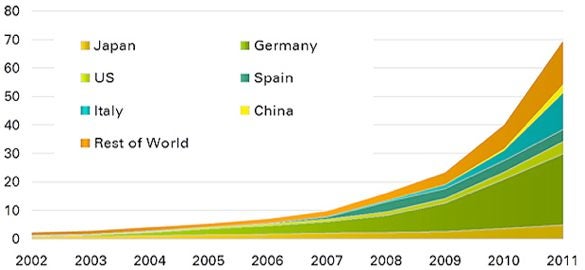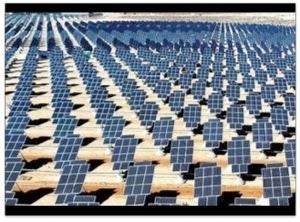Surging Solar in 2011 Proof of Ray Kurzweil’s Bold Prediction?

Share
A recent report by British Petroleum (BP) found solar power generating capacity surged 73.3% last year. If you’re a dedicated fan of the singularity, statistics like that are reminiscent of Ray Kurzweil’s solar dictum—that solar power is on an exponential path, doubling every two years. To what end? A cheap, clean, and virtually boundless power source for humankind in two decades. Nothing major.
The report has some sunny stats for solar enthusiasts. Beyond that 73.3% global capacity jump in 2011 (a record since the data set’s 1996 inception), capacity ended the period at 63.4 gigawatts (GW), ten times greater than its level five years previously.
That’s pretty positive news. As Kurzweil notes, “We are awash in sunlight.” Just 1/10,000 of the sunlight falling on the Earth’s surface can satisfy humanity’s energy requirements. And that doesn’t imply a landscape littered with panels—in fact, an area equal to just a few percent of the Earth’s unused deserts would suffice.

Credit: 2012 British Petroleum Statistical Review of World Energy. Solar power (led by Europe) is on the upswing.
After we’ve solved the energy puzzle, we can move on to other intractable issues, like insufficient food and water. Cheap energy means we can finally afford energy intensive processes like sea water desalination or hydroponic farming. See Kurzweil discuss solar power here (minute 06:15):
But let’s temper our enthusiam for a moment. Mark Twain said, “Facts are stubborn, but statistics are more pliable.”
What’s missing here? Scale, for one thing. Growth of 73.3% isn’t as significant if it’s from a tiny base to a less tiny base.
According to the US Energy Information Administration, renewable energy accounts for 12% of the US energy pie. Hydroelectric is top dog at 4.35% of US energy. Biomass contributes 3.15%, biofuels add 2.57%, wind accounts for 1.45%, and geothermal another 0.29%. Solar contributes just 0.15%. (Of course, those numbers vary country to country and globally—see here for a nice page of energy charts, with sources, from Columbia University.)
Solar capacity is capable of dramatic expansion rates right now, in part, because the technology is still a bit player in the renewable energy drama—and even more so on the larger non-renewable stage. That seemingly gangbusters 100% two-year growth rate would but nudge solar to a tie with geothermal at around 0.3% in the US.
You’ll see similarly stunning growth rates posted by start-up businesses early on. Going from $5,000 in profits to $8,665 doesn’t seem like a giant leap, yet it too is an example of 73.3% growth. The bigger the numbers get, however, the more difficult it is to stay the course. Going from $1 billion to $1.1 billion requires $100 million more in profits—yet is just 10% growth.
Still, Kurzweil thinks people too easily dismiss solar. Sure, it’s as yet a tiny percentage of total energy consumption (0.5% of the whole, he said in 2011), but that doesn’t matter when you’re talking about an information technology. And he thinks that’s just what solar is.
Kurzweil contends solar has been doubling every two years for the last twenty. Proof that it’s already undergoing sustainable exponential growth.
As Singularity Hub readers know, exponential growth is the very foundation of the singularity. We’ve seen computing power grow exponentially in recent decades, tracking Moore’s Law. And the exponential gains of computing spill over into other information-based realms, like genomics, for example.
So, while solar power may only be around 0.5% of the whole, that is a mere eight doublings (or 16 years, 20 including rising energy usage) away from 100%—thanks to the power of exponential growth. (See here for Kurzweil’s chart on solar power’s last two decades.)
The question is, can we compare solar power’s exponential growth to microchips? Is it too an information technology?
Kurzweil compares solar to iPhones, “If you buy an iPhone today, it’s twice as good as two years ago for half the cost.” But the fact that solar capacity has doubled every two years doesn’t prove it’s twice as good at half the cost. There are other factors that must be accounted for also.
The last 20 years have shown exponential growth in solar power—and rising sustainable energy subsidies in parallel.
Be Part of the Future
Sign up to receive top stories about groundbreaking technologies and visionary thinkers from SingularityHub.


Can we disentangle growth due to government incentives from growth due to improvements in the technology?
In the BP report, Europe is the clear leader in new solar capacity—and, not coincidentally, Europe is also the leader in solar subsidies. Artificial demand makes it difficult to see how much of solar’s rapid growth is solely due to advances in the technology.
For example, last year’s solar capacity growth set records because firms expected dramatic cuts in government incentives, thus pulling future demand into the present. And while subsidies add to solar capacity growth now, what might fewer subsidies mean in the future?
Politics are fickle—future growth may prove equally erratic.
Further, the solar industry is battling plummeting solar panel prices in an oversupplied market. Many firms may be caught with a large, expensively produced inventory and no one to sell it to—or at least no way to make a profit.
Government incentives may mask solar power’s true growth potential, but that’s not to say the technology isn’t improving.
The cost of photovoltaic (PV) power modules has decreased 75% in the last three years. Added to lower cost, efficiency is getting better too. The National Renewable Energy Laboratory (NREL) has built photovoltaic devices capable of converting light to electricity at 40.8% efficiency.
The point everyone is aiming for is “grid parity,” when solar becomes cost competitive with traditional energy sources.
While solar hasn’t hit grid parity the world over, it is approaching parity, aided by falling solar prices and rising fossil fuel prices. (Keep in mind parity is not a still point—abundant natural gas, for example, could reverse the trend of rising fossil fuel prices.)
But Kurzweil does not claim to know how we’ll get there, simply that the power of compounding growth rates is immense. And if we extrapolate solar technology’s average growth in the last two decades into the future—our energy woes may be history.
He may be right. Depending on how significantly historical and future growth rates are affected by non-market factors—it may happen in 20 years or 30 or 50. Or never, if some even better technology supplants solar.
What we can say is that solar technology holds promise. And future generations of the technology will build on learning from prior generations. So, subsidies or no subsidies, there is no reason the technology can’t keep up with and eventually leapfrog the competition.
Jason is editorial director at SingularityHub. He researched and wrote about finance and economics before moving on to science and technology. He's curious about pretty much everything, but especially loves learning about and sharing big ideas and advances in artificial intelligence, computing, robotics, biotech, neuroscience, and space.
Related Articles

Startup Zap Energy Just Set a Fusion Power Record With Its Latest Reactor

Scientists Say New Air Filter Transforms Any Building Into a Carbon-Capture Machine

Investors Have Poured Nearly $10 Billion Into Fusion Power. Will Their Bet Pay Off?
What we’re reading


